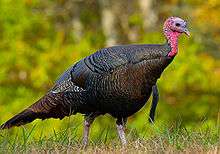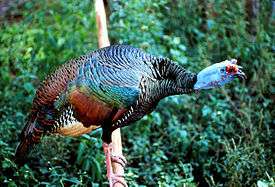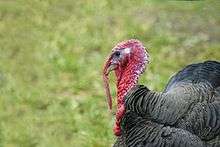Turkey (bird)
| Turkey Temporal range: 23–0 Ma Early Miocene – Recent | |
|---|---|
 | |
| Wild turkey | |
| Scientific classification | |
| Kingdom: | Animalia |
| Phylum: | Chordata |
| Class: | Aves |
| Order: | Galliformes |
| Family: | Phasianidae |
| Subfamily: | Meleagridinae |
| Genus: | Meleagris Linnaeus, 1758 |
| Species | |
The turkey is a large bird in the genus Meleagris, which is native to the Americas. One species, Meleagris gallopavo (commonly known as the domestic turkey or wild turkey), is native to the forests of North America, from Mexico, throughout the midwest and eastern United States, and into southeastern Canada. The other living species is Meleagris ocellata or the ocellated turkey, native to the forests of the Yucatán Peninsula.[1] Males of both turkey species have a distinctive fleshy wattle or protuberance that hangs from the top of the beak (called a snood). They are among the largest birds in their ranges. As in many galliformes, the male is larger and much more colorful than the female.
Taxonomy
Turkeys are classed in the family of Phasianidae (pheasants, partridges, francolins, junglefowl, grouse and relatives) in the taxonomic order of Galliformes.[2] The genus Meleagris is the only extant genus in the subfamily Meleagridinae, formerly known as the family Meleagrididae, but now subsumed within the family Phasianidae.
History and naming

There are two theories for the derivation of the name "turkey" for this bird, according to Columbia University professor of Romance languages Mario Pei.[3] One theory is that when Europeans first encountered turkeys in America, they incorrectly identified the birds as a type of guineafowl, which were already being imported into Europe by Turkey merchants via Constantinople and were therefore nicknamed Turkey coqs. The name of the North American bird thus became "turkey fowl" or "Indian turkeys," which was then shortened to just "turkeys".[3][4][5]
The other theory arises from the fact that turkeys came to England from the Americas via merchant ships from the Middle East where they were domesticated successfully. Again the importers lent the name to the bird: because these merchants were called "Turkey merchants" as much of the area was part of the Ottoman Empire. Hence the name “Turkey birds” or, soon thereafter, “turkeys”.[3][6]
In 1550, the English navigator William Strickland, who had introduced the turkey into England, was granted a coat of arms including a "turkey-cock in his pride proper".[7] William Shakespeare used the term in Twelfth Night,[8] believed to be written in 1601 or 1602. The lack of context around his usage suggests that the term had widespread reach.
In many countries, the names for turkeys have different derivations. Ironically, many of these names incorporate an assumed Indian origin, such as diiq Hindi ("Indian rooster") in Arabian countries, dinde ("from India") in French, Indjushka ("bird of India") in Russia, indyk in Poland, and Hindi ("India") in Turkey. These are thought to arise from the thought that Christopher Columbus had originally believed that he had reached India rather than the Americas on his voyage.[3] In Portuguese a turkey is a peru; the name is thought to derive from the eponymous country Perú.[9]
Several other birds that are sometimes called turkeys are not particularly closely related: the brushturkeys are megapodes, and the bird sometimes known as the "Australian turkey" is the Australian bustard (Ardeotis australis). The anhinga (Anhinga anhinga) is sometimes called a water turkey, from the shape of its tail when the feathers are fully spread for drying.
Fossil record

A number of turkeys have been described from fossils. The Meleagridinae are known from the Early Miocene (c. 23 mya) onwards, with the extinct genera Rhegminornis (Early Miocene of Bell, U.S.) and Proagriocharis (Kimball Late Miocene/Early Pliocene of Lime Creek, U.S.). The former is probably a basal turkey, the other a more contemporary bird not very similar to known turkeys; both were much smaller birds. A turkey fossil not assignable to genus but similar to Meleagris is known from the Late Miocene of Westmoreland County, Virginia.[1] In the modern genus Meleagris, a considerable number of species have been described, as turkey fossils are robust and fairly often found, and turkeys show great variation among individuals. Many of these supposed fossilized species are now considered junior synonyms. One, the well-documented California turkey Meleagris californica,[10] became extinct recently enough to have been hunted by early human settlers.[11] It is believed its demise was due to the combined pressures caused by hunting and by climate change at the end of the last glacial period.[12]
The Oligocene fossil Meleagris antiquus was first described by Othniel Charles Marsh in 1871. It has since been reassigned to the genus Paracrax, first interpreted as a cracid, then soon after as a bathornithid Cariamiformes.
Fossils
- Meleagris sp. (Early Pliocene of Bone Valley, U.S.)
- Meleagris sp. (Late Pliocene of Macasphalt Shell Pit, U.S.)
- Meleagris californica (Late Pleistocene of SW U.S.)—formerly Parapavo/Pavo
- Meleagris crassipes (Late Pleistocene of SW North America)
Turkeys have been considered by many authorities to be their own family—the Meleagrididae—but a recent genomic analyses of a retrotransposon marker groups turkeys in the family Phasianidae.[13] In 2010, a team of scientists published a draft sequence of the domestic turkey (Meleagris gallopavo) genome.[14]
Use by humans
The species Meleagris gallopavo is used by humans for their meat. However, they were first domesticated by the indigenous people of Mexico from at least 800BC onwards. These domesticates were then either introduced into what is now the Southwest US or independently domesticated a second time by the indigenous people of that region by 200 BC, at first for their feathers, which were used in ceremonies and to make robes and blankets.[15] Turkeys were first used for meat by Native Americans by about AD 1100.[15] Compared to wild turkeys, domestic turkeys are selectively bred to grow larger in size for their meat.[16][17] Humans normally eat turkeys on special occasions such as at Thanksgiving or Christmas.[18][19] Properly roasting a turkey is an intense process that is sometimes augmented with other meats into elaborate dishes known as turducken. Vegetarian analogues made from tofu are known as tofurkey, while tofurky is a specific turkey alternative product that is a trademark of Oregon-based Turtle Island Foods.
The Norfolk turkeys
In her written memoirs Lady Dorothy Nevill[20] recalls that her great-grandfather Horatio Walpole, 1st Earl of Orford imported a quantity of the American turkeys[20] which were kept in the woods around Wolterton and in all probability were the embryo flock for the popular Norfolk turkey breeds of today.
Gallery
References
- 1 2 Donald Stanley Farner and James R. King (1971). Avian biology. Boston: Academic Press. ISBN 0-12-249408-3.
- ↑ Crowe, Timothy M.; Bloomer, Paulette; Randi, Ettore; Lucchini, Vittorio; Kimball, Rebecca T.; Braun, Edward L. & Groth, Jeffrey G. (2006a): Supra-generic cladistics of landfowl (Order Galliformes). Acta Zoologica Sinica 52(Supplement): 358–361. PDF fulltext
- 1 2 3 4 Krulwich, Robert (27 November 2008). "Why A Turkey Is Called A Turkey". NPR. Retrieved 18 July 2016.
- ↑ Webster's II New College Dictionary. Houghton Mifflin Harcourt 2005, ISBN 978-0-618-39601-6, p. 1217
- ↑ Andrew F. Smith: The Turkey: An American Story. University of Illinois Press 2006, ISBN 978-0-252-03163-2, p. 17
- ↑ "The flight of the turkey". The Economist. 20 Dec 2014. Retrieved 22 December 2014.
- ↑ Bruce Thomas Boehrer (2011). Animal characters: nonhuman beings in early modern literature p.141. University of Pennsylvania Press
- ↑ Twelfth Night: Act 2, Scene 5 No Fear Shakespeare
- ↑ Dicionário Priberam da Lingua Portuguesa, "peru".
- ↑ Formerly Parapavo californica and initially described as Pavo californica or "California peacock"
- ↑ Jack Broughton (1999). Resource depression and intensification during the late Holocene, San Francisco Bay: evidence from the Emeryville Shellmound vertebrate fauna. Berkeley: University of California Press. ISBN 0-520-09828-5.; lay summary
- ↑ Bochenski, Z. M., and K. E. Campbell, Jr. 2006. The extinct California Turkey, Meleagris californica, from Rancho La Brea: Comparative osteology and systematics. Contributions in Science, Natural History Museum of Los Angeles County, Number 509:92 pp.
- ↑ Jan, K.; Andreas, M.; Gennady, C.; Andrej, K.; Gerald, M.; Jürgen, B.; Jürgen, S. (2007). "Waves of genomic hitchhikers shed light on the evolution of gamebirds (Aves: Galliformes)". BMC Evolutionary Biology. 7: 190. doi:10.1186/1471-2148-7-190. PMC 2169234
 . PMID 17925025. Retrieved 2008-02-15.
. PMID 17925025. Retrieved 2008-02-15. - ↑ Dalloul, R. A.; Long, J. A.; Zimin, A. V.; Aslam, L.; Beal, K.; Blomberg Le, L.; Bouffard, P.; Burt, D. W.; Crasta, O.; Crooijmans, R. P.; Cooper, K.; Coulombe, R. A.; De, S.; Delany, M. E.; Dodgson, J. B.; Dong, J. J.; Evans, C.; Frederickson, K. M.; Flicek, P.; Florea, L.; Folkerts, O.; Groenen, M. A.; Harkins, T. T.; Herrero, J.; Hoffmann, S.; Megens, H. J.; Jiang, A.; De Jong, P.; Kaiser, P.; Kim, H. (2010). Roberts, Richard J, ed. "Multi-Platform Next-Generation Sequencing of the Domestic Turkey (Meleagris gallopavo): Genome Assembly and Analysis". PLoS Biology. 8 (9): e1000475. doi:10.1371/journal.pbio.1000475. PMC 2935454
 . PMID 20838655.
. PMID 20838655. - 1 2 "Native Americans First Tamed Turkeys 2,000 Years Ago". Discovery News. Retrieved December 29, 2015.
- ↑ "Amazing Facts About Turkey". OneKind. Retrieved 24 December 2015.
- ↑ "My Life as a Turkey - Domesticated versus Wild Graphic". PBS. Retrieved 27 December 2015.
- ↑ "Why do we eat turkey for Thanksgiving and Christmas?". Slate. November 25, 2009. Retrieved December 24, 2015.
- ↑ "Why Do We Eat Turkey on Thanksgiving?". Wonderopolis. Retrieved 24 December 2015.
- 1 2 Nevill, Lady Dorothy (1894). Mannington and the Walpoles, Earls of Orford. With ten illustrations of Mannington Hall, Norfolk. Reference to the Sinecure and to the Turkeys. Fine Art Society. p. 22.
External links
- Meleagris at DMOZ
- View the melGal1 genome assembly in the UCSC Genome Browser.
